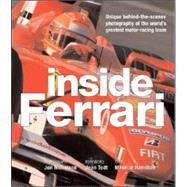
Jon Nicholson is a highly respected Fl photographer who has worked on several best-selling books, notably with Damon Hill during his reign as world champion.
Maurice Hamilton has been an Fl journalist for 25 years and editor of the Grand Prix annual, Autocourse. He is currently a racing commentator on radio.
| Foreword | p. 8 |
| Introduction | p. 10 |
| Factory | p. 16 |
| Testing | p. 46 |
| Car | p. 74 |
| Drivers | p. 124 |
| Racing | p. 174 |
| Family | p. 242 |
| Index | p. 286 |
| Acknowledgments | p. 288 |
| Table of Contents provided by Ingram. All Rights Reserved. |
The New copy of this book will include any supplemental materials advertised. Please check the title of the book to determine if it should include any access cards, study guides, lab manuals, CDs, etc.
The Used, Rental and eBook copies of this book are not guaranteed to include any supplemental materials. Typically, only the book itself is included. This is true even if the title states it includes any access cards, study guides, lab manuals, CDs, etc.